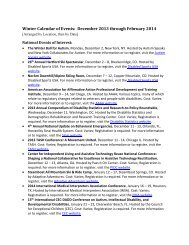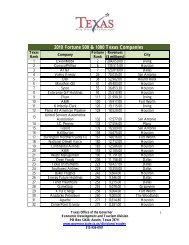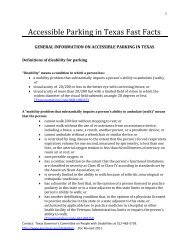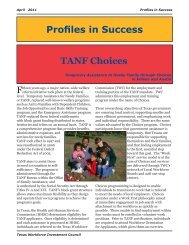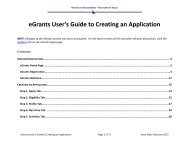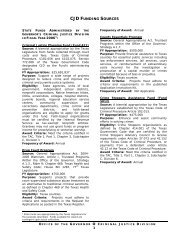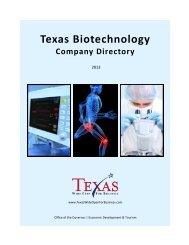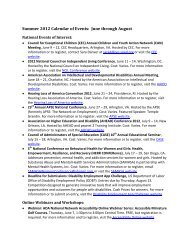People with Disabilities: A Texas Profile
People with Disabilities: A Texas Profile
People with Disabilities: A Texas Profile
You also want an ePaper? Increase the reach of your titles
YUMPU automatically turns print PDFs into web optimized ePapers that Google loves.
Table 19: School Attendance of <strong>Texas</strong> Youth <strong>with</strong> and <strong>with</strong>out <strong>Disabilities</strong>, 2011<br />
School Attendance<br />
Total Number of<br />
Youth between Ages<br />
16 and 24 in Each<br />
Attendance Category<br />
Youth <strong>with</strong><br />
<strong>Disabilities</strong><br />
Youth <strong>with</strong>out<br />
<strong>Disabilities</strong><br />
Number Percent Number Percent<br />
Currently Attending Secondary School 957,239 57,646 6.0% 899,593 94.0%<br />
Currently Attending College 1,043,150 35,282 3.4% 1,007,868 96.6%<br />
Not Currently Attending School 1,307,963 88,961 6.8% 1,219,002 93.2%<br />
Total 3,308,352 181,889 5.5% 3,126,463 94.5%<br />
Table notes: 2011 ACS microdata. Percentages represent the portion of youth <strong>with</strong> and <strong>with</strong>out disabilities<br />
between the ages of 16 and 24 attending secondary school and college (including undergraduate or graduate).<br />
Many youth between the ages of 16 and 24 are not included in labor force participation data because<br />
they are still in school. Table 20 indicates that four percent of labor force participants between the ages<br />
of 16 and 24 had a disability in 2011. Approximately seven percent of youth not participating in the<br />
labor force in 2011 had a disability. The average salary for youth labor force participants <strong>with</strong> disabilities<br />
was $7,816 compared to $11,995 for youth labor force participants <strong>with</strong>out disabilities.<br />
Table 20: Labor Force Participation of <strong>Texas</strong> Youth <strong>with</strong> and <strong>with</strong>out <strong>Disabilities</strong>, 2011<br />
Total Number of Youth <strong>with</strong> Youth <strong>with</strong>out<br />
Youth between <strong>Disabilities</strong><br />
<strong>Disabilities</strong><br />
Labor Force Participation Ages of 16 and 24 Number Percent Number Percent<br />
In Labor Force 1,848,014 76,549 4.1% 1,771,465 95.9%<br />
Not in Labor Force 1,460,338 105,340 7.2% 1,354,998 92.8%<br />
Total 3,308,352 181,889 5.5% 3,126,463 94.5%<br />
Table notes: 2011 ACS microdata.<br />
Even though youth <strong>with</strong> disabilities report similar aspirations for the future as youth <strong>with</strong>out disabilities,<br />
youth <strong>with</strong> disabilities often have limited opportunities to participate in educational and career planning<br />
services (Hitchings et al., 2001). Transition planning and services for youth <strong>with</strong> disabilities are<br />
necessary early in high school to maximize cost‐effectiveness and accessibility (Izzo & Lamb, as cited in<br />
Stewart et al., 2008). These services will enhance the chance for a successful transition into<br />
postsecondary education and a career.<br />
Table 21 illustrates school enrollment and employment status for youth <strong>with</strong> and <strong>with</strong>out disabilities.<br />
As seen in Column C, greater percentages of youth <strong>with</strong>out disabilities are enrolled in secondary or<br />
postsecondary education for every year of age. Column E indicates that greater percentages of youth<br />
<strong>with</strong>out disabilities are also employed full time compared to youth <strong>with</strong> disabilities. Additionally,<br />
greater percentages of youth <strong>with</strong>out disabilities who are employed full time are also enrolled in<br />
secondary or postsecondary education (Column G). Column I illustrates that greater percentages of<br />
youth <strong>with</strong>out disabilities are also employed part time compared to youth <strong>with</strong> disabilities, except for<br />
24‐year‐old youth. Greater percentages of youth <strong>with</strong>out disabilities who are employed part time are<br />
also enrolled in secondary or postsecondary education (Column K), except for 24‐year‐old youth.<br />
30 <strong>Texas</strong> Workforce Investment Council




